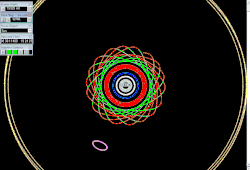5222 Ioffe
Appearance
 Rotating frame animation in reference to Jupiter. Each frame 81 years. | |
| Discovery [1] | |
|---|---|
| Discovered by | N. S. Chernykh |
| Discovery site | CrAO (Nauchnyj) |
| Discovery date | 11 October 1980 |
| Designations | |
| 5222 Ioffe | |
Named after | Abram Ioffe |
| 1980 TL13; 1978 LP 1989 TG1 | |
| main-belt | |
| Orbital characteristics [1] | |
| Epoch 13 January 2016 (JD 2457400.5) | |
| Uncertainty parameter 0 | |
| Observation arc | 22958 days (62.86 yr) |
| Aphelion | 3.1723 AU (474.57 Gm) |
| Perihelion | 2.3780 AU (355.74 Gm) |
| 2.7752 AU (415.16 Gm) | |
| Eccentricity | 0.14311 |
| 4.62 yr (1688.6 d) | |
| 87.106° | |
| 0° 12m 47.484s / day | |
| Inclination | 34.537° |
| 220.67° | |
| 330.91° | |
| Earth MOID | 1.39685 AU (208.966 Gm) |
| Jupiter MOID | 1.86513 AU (279.019 Gm) |
| TJupiter | 3.066 |
| Physical characteristics | |
| 10.96 ± 0.45 km | |
| 19.4 h (0.81 d) | |
| 0.1463 ± 0.012 | |
| B (SMASSII) | |
| 11.4 | |
5222 Ioffe (1980 TL13) is a main-belt asteroid discovered on October 11, 1980 by Chernykh, N. S. at Nauchnyj. It is the largest of the Palladian asteroids apart from Pallas itself.
Photometric observations of this asteroid collected during 2006 show a rotation period of 19.4 ± 0.2 hours with a brightness variation of 0.27 ± 0.03 magnitude.[2]

References
- ^ a b "JPL Small-Body Database Browser: 5222 Ioffe (1980 TL13)" (2015-09-06 last obs.). Jet Propulsion Laboratory. Retrieved 13 April 2016.
- ^ Warner, Brian D. (December 2006), "Asteroid lightcurve analysis at the Palmer Divide Observatory - March - June 2006", The Minor Planet Bulletin, 33 (4): 85–88, Bibcode:2006MPBu...33...85W.
External links
